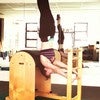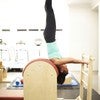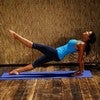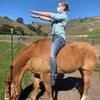Description
About This Video
Transcript
Read Full Transcript
Welcome to that federal fitness class. I guess it's the first one around here. So at least it's the first one for me. So I'm happy to have you here. And um, I will see if I could just cover [inaudible] aspects of the training, which would mean that we start off with probably a little bit of warming up and elastic recoil followed up by federal stretches. And then from there we go to the hydration and the fluid refinement. And, um, I would love to start with the balls. So if you could just have one under one foot first cause because we, um, have a lot of materials recovery.
Who else needs one? You need one to, um, I actually just really would love to go to this right into unit one too. So who else here can you get to? Somebody is missing it all. No. So nice one on a one on one under one foot. Okay. And then as you heard Robert talking before, we really want to squeeze the watery, the water out of the tissues and you really start very slow in a very slow kind of, um, rolling motion.
Meaning you start with your friend food and you get the connective tissues below and you're in the sole of the foot. We want to just get them rehydrated meaning first we get and squeeze the fluids out of the tissues and you need to go really, really small and you meld a little bit into the spot you have, you feel the pressure of the ball and then very, very slowly as if you would just really feel the water just being pushed out of the area. They have the planter, Fisher keep going and roll continuously but very slowly with a kind of a melting pressure the ball until you heal and you may just feel once in a while a really sensitive kind of a spot. It's a kind of look and then stay for a moment and see if you could just nailed into that area.
That connective tissue structure which was forgotten for quite awhile and it is really important to help the forces of the ground just being transmitted into the lower leg and as we walk most of us on concrete and also in shoes, that structure's a little bit sticky to the heel and it should, but it should be moveable, so see if you could just get that heel pad, which is a Fetty connective tissue structure mobile again, so that when we start bouncing the balances can be as they should be easy and fun and really literally elastic and we want to just find that energy in a few minutes.
Usually this even so we didn't do it for a long time. You contribute, just feel the connection to the ground is different, right? Yeah. The connection into the whole side usually is quite different. So you've learned already something about my a festival chains and trains so that something is just really networking up there. And also the proprioception is probably quite alive. So you feel the ground, which is really important for starting moving, especially when we get into a little bit more of vigorous kind of movements, which we do in a minute. But first we get into the second foot, same procedure. You start in the friend of the foot, like the ball of the foot, and then you really work yourself melting and continuously like moving the water. It tish the waters out of the tissues.
You could think about, like I said, people just create a wave in front of a boat and you just go and follow that kind of wave. Yeah. And whenever you feel it as a kind of a walk, say for a moment, melt into find the release so that it, yeah, and sometimes it's surprising you think, wow, that's that little something. Yeah. Right.
So you like see if you could just find a rhythm which is easy and light. Yeah. Okay. Yup. Okay. Yeah. Then you just go view. Just keeps understanding and interests me, which just bounce a little bit and we start bouncing through the ankles through the knees for the hip shines and the ground. Yeah. And just the same, it's like balancing can be like a sack of potatoes.
Bouncing can like be like a spray head can have a spring like quality and you just look for the kind of almost get up to the ceiling. But first it's like hmm. Little kind of springiness into the, in through the joints. Okay. And from there we go on the front foot. Yeah. And you just see what you need to do to move up there, which means like if you have that rubber ball kind of feeling, you have to push a little bit into the ground. Okay. Just hang on here, do this and this one after you. Yeah.
That's just a little bit of gears here and maybe we can do it even a little bit faster. So you are math, maybe you get on the ground on the wooden floor. Just step to the side. Yeah. So then you can also hear the sound you're making. Remember you want to have, we want to have a bounce in movement, which makes the least sound profitable, but the center of really giving up there.
Yup. Okay. Just a little thing here. We have easy financing still like almost going up. Yeah. See the entities like getting lighter and then just be four or five up in the air. Okay. Wait what? Stay here. So just a really nice easy going side race stretch and then watch out that the outside of your heel is still connected to the ground so you're not getting out of the kind of good tension in the leg. And also you stretch a little bit. The central Outta here already.
You really get the leg going. It's an important connective tissue structure here for all the whole health, healthiness of the leg and the mobility of it. So in Abigail here and if you need to go see what you need to do to get yourself over, if you do it a little bit like a bouncing movement. So you need first to push a little bit into the ground to get you over, which is the preparatory counter movement. Yeah. And have you do that? There's ones, I mean no sound but a lot of springiness.
Yup. Yup. Wait, hold on. Okay. And now we can do the middle part just to get a little bit more. So this can make a sound here. Okay. Stay, come back. Small stand. And then you're going to that kind of walking, little jumping and we can just play with little different times, which means like Yup. You get your heels up. Oh, try to make nice challenge. Yeah. Much better. And feelings of what you need to do to do this or you do both.
And if it's getting hard on your tissues, you just bounce in the springiness of your joints. Yeah. Or You could like bounce a little bit stronger here. One foot and site, like a side kick. Yeah. And just, yeah, it just bouncing easy. Yup.
Good alarm. Okay. And your one foot. So usually I do like five to seven and then you go wow. And good. So Watch, I'll do a lick and watch out the connection of your feet. You want to have the big toe, the small toe and the outside of the heel really grounded and connected to the ground, which helps the plant or Fisher to pre-stretch and also to get that outside connective tissue structure working. And that's what we want. So don't collapse here.
This one you really want to. And then I call that the tiger legs. Yeah, that's like a little, a little deer. It's deer, but it's not really strong. Theo and I have this ones here so you could even go a little bit further down. Third bones into your back. Just bone opening. Yeah. Pull your shoulder down to your lower back.
Allen Gate till until the tip of your head. Stay on one side and then really deliberately Ellen gate the outside of your heel into the ground. Bring your chest bone above your knee. Ellen Gates here. Yeah, really get along and business kind of a mental things stretch. Yeah, get back into the middle. Get to the other side. See if you can just find a long chain from the outside of your heel, the outside of your thigh till the friend of your sternum. And maybe you could just feel and get the idea of that tiger body suit.
It's all up here. Pull your shoulder blades down to your lower back. Yeah. And then just feel very, the bare baby you can feel the traction and then just totally ease and melt into that myofascial stretch. Come here, get the fit bones back. Open the chest bone. Open the spine. Yeah. Lean a little bit forward. Watch out. Stay really strong here.
Meaning outside of the heel. The small toe is really alive. Yeah. Cool. And I'll be find the springiness of our lumbar Fascia, which is an important structure for all the holes of your back. And it's a little bit like as if you would just be in Africa working in the fields, meaning your chest is still open, your help and uh, the lumbar spine to get supported by a low valley structure, which you know is [inaudible] quite well and how to do it. So sac, the lower belly back to your spine and open the chest and then just balance with that soft tissue structure called lumber. Those are fashion.
And if we were to pick grass or rice and then you bounce up again and see if you could just find the kind of the springiness like we had before in our legs. Even in that structure, fly up, open the sit bones, get the belly back support to support the lumbers and then come back here used straighten up till the tip of your skull. You find a long chain stretch under your food. Yeah, you'll come back, you got into the other side. Same procedure. You okay? Okay. And from there you grab your rate. [inaudible] I'm gonna I would love to, to go into the next aspect, which is um, the flying sword, which also means means like that we allowed Fascia.
So now we just did load it already through jumping and just with a little bounces and the bouncing movement. But there's another way to load it if it is for weights. And that's something that you really get back into the training as well, is that we want to have a fluid and also as more than subtle elastic body. But we also want to have a strong run so that it can respond to different kinds of challenges in life and this is for that. The rates are really helpful. This one, I'm not too heavy for now but it might be good to try it and you can have the feel how it feels to get back into the loop with of like a weight lifting mode and how we use it and for sure after a while you can really increase volume but it's probably, we do a few of those motions which you're not so used to.
It might be a very good at here to start really low. Okay. The flying it is emotion which starts with a, to show you first that kind of bringing the sword, this is this one back. I'm going to show it this way between your legs and you really want to bring it way back and get the private group, Tory counter movement going way, bringing the weight back and then moving up. And then before you go down again you want to bring the raid also back to really pre-stretch and open the front part of the connective tissue cap bodysuit. So, and then I go back and come up and go back and come up in the lake. That what we said before, before I come up, I really get an emphasis in just moving back first so that I'm more or less like fly up again. So it's not like an effort in flight in, in getting up.
Three stretches the bow before and then she'll let shoots off the error. Right? And that's what we do now. And please make sure you promise me to just hold that thing really tight. Okay, so let's just give it a try. So you go back first and see how much you need to go back to be able to fly up. And this is the same thing as Robert showed on that little springs.
You need to find your own rhythm and your own pre-stretch. There is no rule for that. So feel into lots of the right kind of motion you have to, you can bring back. Yes, it's great to have that psych sense of ease and flow. Next time you're up you're to stay up and get your whole cat body suits engaged, meaning you really bring the stretch down till under your plantar Fascia and you along Gaye the thoracic spine, a little bit into the ceiling and you pull back a little bit to even get more stretch going. And now it started with a little kind of a bamboo Ellis tricity wave.
Yeah, mini bounces to even load the fashional sheets and membranes a little stronger. Lower your shoulder blades. Yeah, and see if it, that also can be like a little elastic kind of a bounce. And now the tricky part is if you fly down again, you'd just get the bouncing motion back and the sternum really pulling you in friend. And from that kind of lip, whiplash kind of motor, you fly up lap, you know, same procedure. We do it a few times to us in a slow motion. Yeah. Find the whole body stretch. So under the let your feet get the whole friend cad body suit engaged.
Yeah. Watch out your lumbers. So yeah, that, that it's really supported by your lower belly muscles. And then you go get the minivans is going, pull your shoulder blades back down. And if the bamboo electricity's starting, you really bring it back. Let yourself pulled by the storm in front and then your chest fly back in a wonderful and a stick. Waif. Okay. If you have this, do it five times in a row. No, stop.
Great. And I'll be played with a few little variations, meaning you're telling a little bit more outside to rotate a little stay there until the find a mini bouncing motion. That one great. Yup. Stay connected to the of the ground. Come back into the middle and just turn the other way. That's the little bit with the upper body. And you still have the connections under your planter.
Fresher move, the thoracic spine up and back and just a mini bounds just a little bit. Yup. Okay. Slowly come in front, slow motion back here, middle. And I need to just a few, I have to wait in my right hand and then we just do a few of those kind of waving, swinging motions. And it's nice if you could just stay with flat feet and really keep the connects. And this was a hit. So any, I knew go this may one side and you sway from one side or the other with you. Yeah. And tough.
Keep the connection into the ground. Don't fall into a flack here. You really want to have strong tissues here. So you really stay in a tiger like kind of position. Yep. Good. So
Nice. Show into the same direction. Feet are flat. I want to have the rotation into the upper body. Okay, great. So it go this way. Yeah. And you really go to the very end and stays stable and hold the feet connected into the ground. Next time you're out and rotated to the, into the back, keep still and then test another kind of mini bouncing down outward in that outward rotation. Yeah, just a fee for five.
Get back, shift the weight. I did this one again. [inaudible] really connected yet. Picto small toe outside of the heel. Don't collapse. Yeah, exactly. Yup.
And then lead to this kind of swinging motion we first have like side and think I could just yell at him also. He'll find an easy and fun rhythm. Yep. Exactly. Okay. Let me shift and go back front and to really rotate. Yeah. To an end range of motion. Yeah.
Back and see, maybe it's, you can already start doing it with a little kind of energetic momentum if your tissues allow that, be careful, but maybe it's really fun to find that kind of elastic recall. Energy Quality. Yep. Okay. Last time. Then you stay rotated to the back and then just a few of those mini bounces. Your eyes follow into the back. Yup. Really small. The balances are mini and that's the trick. Yep.
And feel the tricks and maybe the envelopes around your back, the rallies, the front part of your chest and come back. So that'd be follow with the flying thought part two which is your hot me to friend. Second part of the flying sword is we did the first one which goes up here, do the pulling back, the preparatory counter movement to really load the Fascia. We pull back here and now we take a turn, you turn upwards, go back, watch od your neighbor. And then we did like a few times in a row. Okay. Okay.
Does to load the festival sheets in different kinds of angles. Yeah, that's a very good idea to really clear your neighborhood. It's all, yeah, and you want to fly up and down and you need to prepare the flying by pulling back by. Yeah. Getting that preparatory counter movement and the proximal initiation initiation they have. Well, I can help you. I can do it. You can do it with me. So let me do this one. Here you go first in the middle, then you take a turn up and then you pull back and the sternum pulls you and friend down here on the side. Rotation up and then down again. Yeah, but you really want to do a circle. Yeah.
You Really wanna circle up. Yeah. You want to load the tissues, Don, do too often. You want to be happy tonight to get up here. Shift the legs a little bit, the feet just facing it in the other, in the opposite direction. Bend your knee, pull the rear bag into the ground. Long chain. Stretch for the shoulder blades, back to your sit bones.
Open the chest. And then just that little kind of mini bonds and cure. Yeah, and see if you could just become a bamboo, even if it's very small, really elastic, like a green, fresh bamboo. Then you rotate outwards to test, find another angle you find yours. And I'm just a little bit of a mini balance of bouncing cam back in the middle or tight in the opposite direction. Pull the thoracic spine up into the air and lean back. Still connected under your feet.
The whole cat bodysuit is engaged and I'm just a mini balancing three, five, seven times. Move Back, move the weight down, shift the position, come down, hold it. So this one is nice with a little bit of a heavier one, but it's really nice to do the picking up of the African feeling, but that kind of having something in your hand. So help your lumbers with the lower belly muscles and open the chest. And then just play angles, middle friend side, middle friend, and see that you feel like the most pleasurable LSD [inaudible] yeah, and bounds. Yup. Great. Okay. Let it just drop into the ground.
Never will. Your next move them in where it's a little, and now I get up here, I'm there. So we are here. All right. From there you walk with your hands array. It's like two or three little steps away from your feet coming up in that upstretched position. And now we just get that little feet walking like a cat again going, you really walk until you're the sole of your feet and until your heel pat. So this is first, maybe I'll have a little bit slower and the heel and the knee alternate. And when the he comes forward, your sit bones sit bone, the opposite, that bone moves back.
Right. And Avi too. It's just a little bit. Yep. And even if you like to, you could just also
It's the cab which is like really getting the toes. Yeah and the yeah. Pause until the mat or into the ground. Push yourself in up to the sit bones and just the little bit of a bouncing through the Alister city of your spine. Toasts are engaged.
He lists long and just a little bit of a bouncing, get back on all forth, come down, get on your heels and rest for a moment. Yeah, so I would love to get that power stretch into the upper body and like the cat is just stretching first into that more elongating position in front like you bring to the upper body app and it's like the cat would do to prepare to Frist. The cat is just really getting along and that's what you do. You really get along, you get along until you're the tip of your fingers. You could do long into the tip of your table.
You get along into the tips of your sit bones. Right. It's just meld into that length in sowing the melting, so, okay. And if the cat has enough of that kind of melting, you get the fingertips sucked into the ground, like into the couch,
It's a difference from what did it maybe before so that the chest bone comes in front. Right. Cool. And then from there you get up here and you push back into the up stretch. You elongate the Achilles tendon by bringing heels down, you feel the stretch off the envelopes around your carves, the connective tissue structures. And now you find little bit of and motion to really open that envelopes and you need to just play with a little bit of variation. No static stretch. Just a little bit of maybe bending, little bit of rotation.
Yeah. Little bit of ELL engaged enough. The sit bones will make a difference. Really small, tiny, tiny changes. Yup. Cool. And then you push back again, fully arms and maybe you could just go a little bit of the wave emotion going through your spine so that the spine also gets a little bit of a allegation. Yup. Get back, come down, push back on your heels, rest for a moment. And chest enzyme that along Jason and the stretch here.
Yeah. And maybe your cat body is already a little bit awake. So the petit correlations and all that. Yup. Little, yeah, the little rotations, the little some things which just really feel like, mm. My professional hygiene.
Okay. From there you bring yourself up. I have one more thing for finishing up, which means we turn around and we get a little bit in mind that um, spinal wave motion, meaning that the spine is the little bit like that kind of 10 secretary kind of structure, which is not a column, but we create space and fluidity around it and you bring yourself on your back and you find the space of the feet connected to the pelvis so that you have that little kind of bridge under your lumbers, which you know better than I do. Could you really get off of your melt the rip basket and just can just melt a little bit downwards to your pelvis. And then you imagine yourself being a sting ray, um, on the sand and really down in the laying in the ocean like the beautiful ocean. We have here and your chest move that like a sting ray would move.
I'm that ground and into the ground and you just find little spots of connection and detailed motion. And if it's hard to understand, it's really, you're really welcome to just look up here for a moment, which means I really
Are Paolo still and the Po and the spy in boots just be lifted
And even lower so that at a time your sake from starts descending and maybe there's a little kind of a [inaudible] motion still going as if that sick would also be able to dance in the water micro movement, micro waving movements and from there you release and then just see what your pelvis and the lower back wants to move. If they just, if you just allow yourself to move, like if the purpose which has to be held in the sand and the water which has flow underneath. And just to finishing up just for a moment, allow yourself the most centers pressu pleasurable movement, which is possibly um, flowing fluid kind of emotion so that you're not only moving fibers but you're moving the fluid dynamics of the connective tissue, which I also call the inner ocean. And that should be easy because we were surrounded by ocean here. So just invite the ocean to move you and then stretch out your legs to just take a moment of just feeling into and relax for a moment, status for a moment and just feel the connection from the tip of your toes till the tip of your skull
Fine the interveaving neck from side to side. And maybe there's motions and movements coming along. That's wonderful. And from there, find the movement of the ocean, which is called ground substance and part off the connective tissue and as well important and all your soft tissues are embedded. And that in that kind of fluidity, and there's nothing to do, it's just something which is there. And you could just roll, receive that fluid nourishment into the festival that,
Maybe you want to test stretch a little John A. Little after the cat body body wants to do. Yeah. And then rather you roll on your side or your chest, bring the knees up to bring your back into sitting by that. It was a quick one time moved like that. So thank you so much. That was fun and I saw a wonderful movement, especially at the end. It was really, really wonderful, really refined. That's a great pleasure for me to see that, so thank you. Okay, great.
Comments
elevation of the spirit definitely engaged ;)
thank you.
You need to be a subscriber to post a comment.
Please Log In or Create an Account to start your free trial.




























